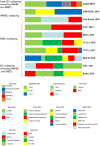Traditional Classification and Novel Subtyping Systems for Bladder Cancer
- PMID: 32117752
- PMCID: PMC7025453
- DOI: 10.3389/fonc.2020.00102
Traditional Classification and Novel Subtyping Systems for Bladder Cancer
Abstract
Bladder cancer is the most common tumor in the urinary system, with approximately 420,000 new cases and 160,000 deaths per year. The European Organization for Research and Treatment of Cancer (EOTRC) classifies non-muscular invasive bladder cancer (NMIBC) into low-risk, medium-risk and high-risk groups based on a comprehensive analysis of NMIBC pathological parameters and the risk of recurrence and progression to muscular invasive bladder cancer (MIBC). Traditional classification systems are based on pathologic grading, staging systems, and clinical prognosis. However, the pathological parameters of the tumor cannot fully reflect the "intrinsic characteristics" of bladder cancer, and tumors with a similar pathology exhibit different biological behaviors. Furthermore, although the traditional classification system cannot accurately predict the risk of recurrence or the progression of bladder cancer patients (BCs) individually, this method is widely used in clinical practice because of its convenient operation. With the development of sequencing and other technologies, the genetics-based molecular subtyping of bladder cancer has become increasingly studied. Compared with the traditional classification system, it provides more abundant tumor biological information and is expected to assist or even replace the traditional typing system in the future.
Keywords: EOTRC; bladder cancer; clinical prognosis; molecular subtypes; multiomics.
Copyright © 2020 Zhu, Yu, Yang, Wu and Cheng.
Figures




References
Publication types
LinkOut - more resources
Full Text Sources
Other Literature Sources

